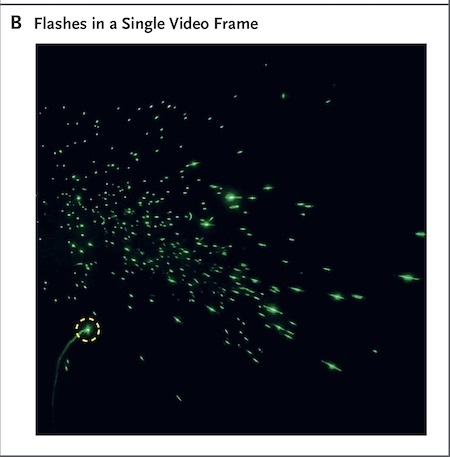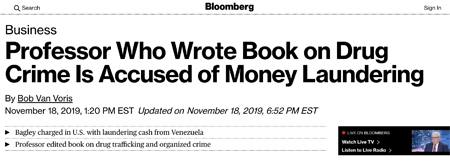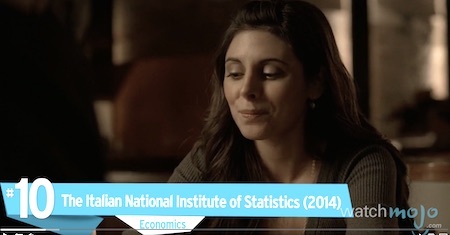Marc Abrahams's Blog, page 119
April 25, 2020
Pocket-Sized #1004: “Mask Wiggling”
Mask Wiggling
In this Pocket-Sized episode #1004, Marc Abrahams shows an unfamiliar research study to Mason Porter. Dramatic readings and reactions ensue.
The research mentioned in this episode is featured in the special Mathematics issue (Vol. 16, #4) of the Annals of Improbable Research magazine.

Remember, our Patreon donors, on most levels, get access to each podcast episode before it is made public.
1. Mason Porter encounters:
“The Effect of Facial Hair and Sex on the Dispersal of Bacteria Below a Masked Subject,” H.A. McLure, M. Mannam, C.A. Talboys, B.S. Azadian and S.M. Yentis, Anaesthesia. vol. 55, no. 2, February 2000, pp. 173-6.
Seth Gliksman, Production Assistant
Available on Spotify, Apple Podcasts, Overcast, Google Podcasts, AntennaPod, BeyondPod and elsewhere!

April 24, 2020
Disproof of “Those who can’t do, teach”?
The news headline “Professor Who Wrote Book on Drug Crime Is Accused of Money Laundering” seems to refute the old joke that “Those who can’t do, teach“.
The report, from Bloomberg News, on November 18, 2019 begins:
A Miami professor who’s an expert on drug trafficking and organized crime was charged by the U.S. with laundering money from Venezuela, skimming more than $250,000 for himself.
Bruce Bagley, 73, a professor of international studies at the University of Miami, was the co-editor of the 2015 book “Drug Trafficking, Organized Crime, and Violence in the Americas Today” as well as a contributor to various journals on the topic.

April 22, 2020
Pocket-Sized #1003: “Dogs’ Favorite Garbage”
Dogs’ Favorite Garbage
In this Pocket-Sized episode #1003, Marc Abrahams shows an unfamiliar research study to Melissa Franklin. Dramatic readings and reactions ensue.
The research mentioned in this episode is featured in the special Blushing issue (vol. 19, #2) of the Annals of Improbable Research magazine.

Remember, our Patreon donors, on most levels, get access to each podcast episode before it is made public.
1. Melissa Franklin encounters:
“Determination of Favorite Components of Garbage by Dogs,” Bonnie V. Beaver, Margaret Fischer, and Charles E. Atkinson, Applied Animal Behaviour Science, vol. 34, no. 1, 1992, pp. 129–36.
Seth Gliksman, Production Assistant
Available on Spotify, Apple Podcasts, Overcast, Google Podcasts, AntennaPod, BeyondPod and elsewhere!

Pocket Sized #1003: “Dogs’ Favorite Garbage”
Dogs’ Favorite Garbage
In this Pocket-Sized episode #1003, Marc Abrahams shows an unfamiliar research study to Melissa Franklin. Dramatic readings and reactions ensue.
The research mentioned in this episode is featured in the special Blushing issue (vol. 19, #2) of the Annals of Improbable Research Magazine.

Remember, our Patreon donors, on most levels, get access to each podcast episode before it is made public.
1. Melissa Franklin encounters:
“Determination of Favorite Components of Garbage by Dogs,” Bonnie V. Beaver, Margaret Fischer, and Charles E. Atkinson, Applied Animal Behaviour Science, vol. 34, no. 1, 1992, pp. 129–36.
Seth Gliksman, Production Assistant
Available on Spotify, Apple Podcasts, Overcast, Google Podcasts, AntennaPod, BeyondPod and elsewhere!

Pocket-Sized #1002: “Food Allergies and Kissing”
Food Allergies and Kissing
In this Pocket-Sized episode #1002, Marc Abrahams shows some unfamiliar research studies to Christina Agapakis. Dramatic readings and reactions ensue.
The research mentioned in this episode is featured in the special Kissing issue (vol. 22, #4) of the Annals of Improbable Research magazine.

Remember, our Patreon donors, on most levels, get access to each podcast episode before it is made public.
1. Christina Agapakis encounters:
“Food Allergies and Kissing,” Rosemary Hallett, Lori Haapanen, and Suzanne Teuber, New England Journal of Medicine, vol. 346, no. 23, June 6, 2002, pp. 1833-1834.
“Oral Allergy Syndrome to Apple After a Lover’s Kiss,” B. Wuthrich, Allergy, vol. 52, 1997, pp. 235-6.
Seth Gliksman, Production Assistant
Available on Spotify, Apple Podcasts, Overcast, Google Podcasts, AntennaPod, BeyondPod and elsewhere!

April 21, 2020
Golfer’s Yips Mitigator [new patent]
What are ‘The Yips’ – and what, if anything, can be done about them?
“Certain golfers may experience a phenomenon called `yips.` The term `yips` or `the yips` refers to a condition known as focal dystonia. Athletes affected by the yips demonstrate a sudden, unexplained loss of previous skill. The condition may occur suddenly and without apparent explanation, usually in mature athletes with years of experience. There is no known treatment or therapy in the current state of the art.”
 Inventor Brock Gause has just been granted a US patent for a ‘Sports training apparatus to address focal dystonia’ which might go some way towards mitigating the problem. Here’s how the patent describes its workings (which can be understood with reference to the drawing above).
Inventor Brock Gause has just been granted a US patent for a ‘Sports training apparatus to address focal dystonia’ which might go some way towards mitigating the problem. Here’s how the patent describes its workings (which can be understood with reference to the drawing above).
“One end of the apparatus comprises a mouthpiece that is sized to accommodate insertion into the mouth of an athlete. The opposite end of the apparatus is shaped to be rotatably attached onto a container with a screw top, such as a water bottle or sports drink container. An athlete, such as a golfer, may practice a sporting technique, such as swinging a golf club, while focusing on keeping liquid within the container still, which minimizes stress and anxiety caused by performance expectations.”
See: US patent 10617930, 14th April, 2020.
Research research by Martin Gardiner

April 19, 2020
AAAS Twitter discussion about Surprising Things, Monday!
Join us and some surprising people in a twitter discussion about surprising things in science.
This is part of the AAAS’s new Virtual Media initiative. The AAAS is of course the American Association for the Advancement of Science, which publishes Science magazine, organizes the AAAS Annual Meeting (at which we have done an Improbable Research show every year for the past quarter century), and does lots more.
WHEN— Monday, April 20, from 1pm to 3pm, US Eastern time.
WHERE— See the discussion on Twitter, at https://twitter.com/search?q=%23AAASmtg
HOW— To be part of the discussion, tweet your thoughts, on Twitter. Be sure to include the hashtag #AAASmtg in each of your tweets.
WHO— These are some of the people who will be in the discussion. You can join them:
Marc Abrahams, editor, Annals of Improbable Research, and founder of the Ig Nobel Prize ceremony. @MarcAbrahams, @ImprobResearch
Rebecca Helm, discoverer of a method to grow jellyfish in captivity. Rebecca is an assistant professor at the University of North Carolina, Asheville. @RebeccaRHelm
David Hu, double Ig Nobel Prize winner, for testing the biological principle that nearly all mammals empty their bladders in about 21 seconds (plus or minus 13 seconds), and also for studying how, and why, wombats make cube-shaped poo. David is Associate Professor of Mechanical Engineering and Biology at Georgia Tech. @drdavidhu
Patricia Yang, double Ig Nobel Prize winner, for testing the biological principle that nearly all mammals empty their bladders in about 21 seconds (plus or minus 13 seconds), and also for studying how, and why, wombats make cube-shaped poo. Patricia is a postdoc at Stanford University. @pyang_tweet
Olga Shishkov studies the collective dynamics of maggots. Olga is a doctoral student at Georgia Tech. @o_shishk
Nicole Sharp, fluid dynamicist, founder of FYFD, the world’s most popular fluid dynamics web site. Nicole is also an organizer of the Ig Nobel Prize ceremony. @aerognome, @fyfluiddynamics
Mark Dingemanse, Ig Nobel Prize winner for discovering that the word “huh?” (or its equivalent) seems to exist in every human language — and for not being completely sure why. Mark is Associate Professor in Language and Communication at Radboud University, The Netherlands. @DingemanseMark
Dany Adams studies bioelectricity and lots of other biology. She is chief scientist at Ion Dynamics. Dany is also an organizer of the Ig Nobel Prize ceremony. @datoms61
Kees Moeliker, Ig Nobel Prize winner for discovering homosexual necrophilia in the mallard duck. Kees is Director of the Natural History Museum in Rotterdam, The Netherlands. Kees is also an organizer of the Ig Nobel Prize ceremony. @KeesMoeliker
Marc-Antoine Fardin, Ig Nobel Prize winner for using fluid dynamics to probe the question “Can a Cat Be Both a Solid and a Liquid?” Marc is a physicist at Université Paris Diderot, France. @FardinMarc
We will talk about all sorts of thing, including maybe these videos:

April 18, 2020
Masked and Un-Masked Spittle Produced When One Says “Stay Healthy”
The biomedical race to understand and tame the COVID-19 virus proceeds rapidly, drop by drop. This new spittle study is the very latest addition to the literature:
“Visualizing Speech-Generated Oral Fluid Droplets with Laser Light Scattering,” Philip Anfinrud, Valentyn Stadnytskyi, Christina E. Bax, and Adriaan Bax, New England Journal of Medicine, April 15, 2020. (Thanks to Andrea DeMeter for bringing this to our attention.) The authors, at the National Institutes of Health and the University of Pennsylvania, report:

Aerosols and droplets generated during speech have been implicated in the person-to-person transmission of viruses, and there is current interest in understanding the mechanisms responsible for the spread of Covid-19 by these means. The act of speaking generates oral fluid droplets that vary widely in size, and these droplets can harbor infectious virus particles….
We report the results of a laser light-scattering experiment in which speech-generated droplets and their trajectories were visualized. We found that when the person said “stay healthy,” numerous droplets ranging from 20 to 500 μm were generated….
We found that when the person said “stay healthy,” numerous droplets ranging from 20 to 500 μm were generated…. When the same phrase was uttered three times through a slightly damp washcloth over the speaker’s mouth, the flash count remained close to the background level (mean, 0.1 flashes); this showed a decrease in the number of forward-moving droplets.
BONUS: The COVID-19 pandemic is producing bizarre adventures for biomedical professionals. The New England Journal of Medicine has a letter from one of them:
Our supply-chain group has worked around the clock to secure gowns, gloves, face masks, goggles, face shields, and N95 respirators… Before we could send the funds by wire transfer, two Federal Bureau of Investigation agents arrived, showed their badges, and started questioning me. No, this shipment was not headed for resale or the black market. The agents checked my credentials, and I tried to convince them that the shipment of PPE was bound for hospitals. After receiving my assurances and hearing about our health system’s urgent needs, the agents let the boxes of equipment be released and loaded into the trucks. But I was soon shocked to learn that the Department of Homeland Security was still considering redirecting our PPE. Only some quick calls leading to intervention by our congressional representative prevented its seizure. I remained nervous and worried on the long drive back, feelings that did not abate until midnight, when I received the call that the PPE shipment was secured at our warehouse.
This experience might have made for an entertaining tale at a cocktail party, had the success of our mission not been so critical.

Pocket-Sized #1002: “Food Allergies and Kissing”
Food Allergies and Kissing
In this Pocket-Sized episode #1002, Marc Abrahams shows just a wee bit of unfamiliar research studies to Christina Agapakis. Dramatic readings and reactions ensue.
The research mentioned in this episode is featured in the Kissing Special Issue (Vol. 22, #4) of the Annals of Improbable Research Magazine.

Remember, our Patreon donors, on most levels, get access to each podcast episode before it is made public.
1. Christina Agapakis encounters:
“Food Allergies and Kissing,” Rosemary Hallett, Lori Haapanen, and Suzanne Teuber, New England Journal of Medicine, vol. 346, no. 23, June 6, 2002, pp. 1833-1834.
“Oral Allergy Syndrome to Apple After a Lover’s Kiss,” B. Wuthrich, Allergy, vol. 52, 1997, pp. 235-6.
Seth Gliksman, Production Assistant
Available on Spotify, Apple Podcasts, Overcast, Google Podcasts, AntennaPod, BeyondPod and elsewhere!

Another Top Ten Ig Nobel Prize Winners video
Marc Abrahams's Blog
- Marc Abrahams's profile
- 14 followers






